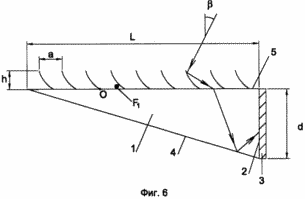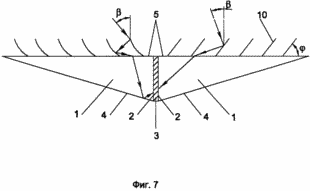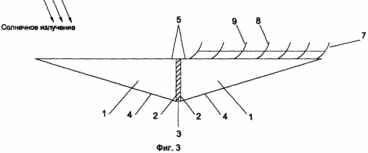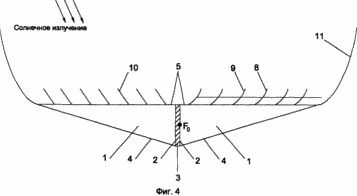| Start of section
Production, amateur Radio amateurs Aircraft model, rocket-model Useful, entertaining |
Stealth Master
Electronics Physics Technologies Inventions |
Secrets of the cosmos
Secrets of the Earth Secrets of the Ocean Tricks Map of section |
|
| Use of the site materials is allowed subject to the link (for websites - hyperlinks) | |||
Navigation: => |
Home / Patent catalog / Catalog section / Back / |
|
INVENTION
Patent of the Russian Federation RU2133415
![]()
SOLAR PHOTOELECTRIC MODULE (OPTIONS)
The name of the inventor: Strebkov DS; Bezrukih PP; Tver'yanovich EV; Irodionov AE
The name of the patent holder: All-Russian Scientific Research Institute of Agriculture Electrification
Address for correspondence: 109456, Moscow, 1-st Veshnyakovskii pr.2, VIESKH, ONTI and patents
Date of commencement of the patent: 1998.04.29
The invention relates to solar energy, in particular solar photovoltaic modules with solar concentrators for producing electricity and heat. The invention makes it possible to create a photoelectric module with a static concentrator having dimensions in cross section, commensurate with the dimensions of a flat photoelectric module having an increased specific power of the photo converter. The above technical result is achieved by the fact that in a solar photovoltaic module made in the form of a total internal reflection prism 1 having a working surface 5, a rear mirror surface 4 and a lateral smaller face 2 on which commutated photoconverters 3 are mounted, on the working surface 5 of the prism 1, In several rows of miniature mirror screens 7 with a two-sided mirror surface whose planes are oriented towards the face 2 of the prism 1 containing photoconverters 3. In the solar photovoltaic module, at least on one side of the module, there is a mirror reflector 11 in the form of a parabolic cylindrical focline with a focus located in Plane of the photoconverter.
DESCRIPTION OF THE INVENTION
The invention relates to solar helix, in particular solar photovoltaic modules with solar concentrators for producing electricity and heat.
A solar photoelectric module with a concentrator is known, made in the form of a prism of total internal reflection (DRMils, JE / Giutronch, Ideal Prism solar Concentratois, Solar Energy. Vol.21, 1978, p.423).
The disadvantage of the known photoelectric module is the low concentration coefficient. This is due to the fact that at the angle of the radiation input with respect to the normal to the surface ± 23.5 °, the minimum angle at the apex of the prism is 28 ° , and the concentration coefficient K = 1 / sin ![]() = 1.8. To increase the prism concentration coefficient, it is necessary to reduce the angle at the apex of the prism, however, the slope of the radiation increases and the radiation losses caused by the deviations of the radiation flux from the optimum perpendicular to the prism surface increase.
= 1.8. To increase the prism concentration coefficient, it is necessary to reduce the angle at the apex of the prism, however, the slope of the radiation increases and the radiation losses caused by the deviations of the radiation flux from the optimum perpendicular to the prism surface increase.
The closest in technical essence to the proposed invention is a photoelectric module with a concentrator based on parabolic cylindrical foclines installed on both sides along the edges of photoconverters (Solar Tobay, Yuly / August 1997, p. 31).
The disadvantage of the known module is a low concentration ratio of 2 to 2.5. Another disadvantage is the large height of the module with the concentrator, exceeding the size of a flat photoelectric module without a concentrator by 4 to 6 times. The disadvantages of both known types of photovoltaic modules is the low specific power of the photoconverter.
The object of the present invention is to provide a photoelectric module with a static concentrator having dimensions in cross section, commensurate with the dimensions of a planar photoelectric module and having an increased specific power of the photoconverter.
As a result of using the proposed solar photoelectric module, the specific power of the photoconverter increases.
The above technical result is achieved by the fact that in a solar photovoltaic module with an energy concentrator made in the form of a total internal reflection prism having a working surface on which radiation falls, a rear mirror surface and a lateral smaller face on which commutated photoconverters are mounted, on the working surface of the prism Are installed in several rows of miniature mirror screens with a two-sided mirror surface, the planes of which are oriented in the direction of the prism face, containing photoconverters. Miniature mirror screens are made in the form of blinds from parallel equally oriented halves of parabolic cylindrical foclines, the concave surface of which faces the photoconverter, and the focus of each fooclin is located under the convex surface of the adjacent foclin in the immediate vicinity of the edge of its outlet. Miniature mirror screens can be made in the form of a shutter made of flat mirror facets, the plane of which is inclined to the working surface of the prism at an angle of 60 - 90 ° .
In another modification of the proposed photoelectric module with an energy concentrator, two total internal reflection prisms are mounted symmetrically and interconnected in such a way that the photoconverter is common to both prisms, and the miniature mirror screens are mounted symmetrically opposite to both prisms or on one of them. In yet another modification of the solar photoelectric module with an energy concentrator on at least one side of the module, a mirror reflector in the form of a parabolic-cylindrical Focline with a focus located in the plane of the photoconverter is installed.
 |
 |
||
| |||
 |
 |
||
 |
In Fig. 1 shows a solar photoelectric module with one prism and miniature mirror screens in the form of blinds from parallel parabolic cylindrical foclines, a cross section; In Fig. 2 - solar photoelectric module consisting of two prisms with miniature mirror screens; In Fig. 3 - solar photoelectric module consisting of two prisms, one of which has miniature mirror screens, from parabolic cylindrical foclines; In Fig. 4 - solar photovoltaic module of two prisms with miniature mirror screens of foclines and flat facets; on each side of the module there are mirror reflectors in the form of a parabolic-cylindrical focline with a common focus located in the plane of the photoconverter; In Fig. 5 shows a solar photoelectric module of two prisms, one of which has miniature mirror screens of flat mirror facets. 6 and 7 show the path of the rays in the solar photovoltaic module. |
||
The solar photoelectric module with the energy concentrator contains a prism of the total reflector 1, on the side face 2 of which a photoconverter 3 is mounted. The prism has a rear mirror surface 4 and a working surface 5 on which radiation is incident. On the working surface of the prism 5, miniature mirror screens 7 of the halves of parabolic cylindrical microfoclines 8 connected in a louver 6 are installed, the plane of the upper half of the microfoclines and their optical axis parallel to the plane of the photoconverters 3. The focus F of each half of the microfocline 8 is located on the side close to the photoconverter 3 in the immediate Proximity to the convex surface of the adjacent half of the microfocline 9 located between the first half of the microfocline 8 and the photoconverter 3.
In Fig. 2, the two prisms 1 have a common two-way photoconverter 3 and a working surface 5 on which there are louvers 6 consisting of miniature mirror screens 7 of parabolic cylindrical microfoclines 8, the concave surface of the microfoclines 8 facing the photoconverter 3.
In Fig. 3, one of the prisms 1 has on the working surface 5 blinds 6 of miniature mirror screens 7 in the form of halves of parabolic cylindrical microfoclines 8, and the second prism 1 does not contain mirror screens.
In Fig. 4 one of the prisms 1 has on the working surface 5 blinds 6 of miniature mirror screens 7 in the form of microfoclines 8, and the second prism - miniature mirror screens in the form of flat mirror microfacets 10. On each side of the module there is a mirror reflector 11 in the form of a parabolocylindrical focline with a focus F 0 located in the plane of the photoconverter 3.
In Fig. 5 one of the prisms 1 has miniature mirror screens on the working surface 5 in the form of flat mirror microfacets 10, and the second prism 1 does not have mirror screens.
In Fig. 6, 7, the angle between the working surface 5 and the rear mirror surface of the prism is ![]() 0 , the radiation input angle
0 , the radiation input angle ![]() , The focal length of the microfocline OF 1 , the distance between the microfoclines or between the flat mirror facets a, the width of the working surface of the prism L, the width of the photoconverter d, the angle of inclination of the plane of the facet 10 to the working surface of the 5-
, The focal length of the microfocline OF 1 , the distance between the microfoclines or between the flat mirror facets a, the width of the working surface of the prism L, the width of the photoconverter d, the angle of inclination of the plane of the facet 10 to the working surface of the 5- ![]() , Height of mirror screens h.
, Height of mirror screens h.
An example of a specific implementation of a photoelectric module.
Prism 1 is made hollow with a top glass made of hardened glass with low iron content, the back and side surfaces of the prism are made of glass of galvanized steel or aluminum and have a mirror coating. The prism is filled with an optically transparent liquid, for example, an organosilicon fluid, oil or water. The width of the prism is L = 500 mm, the width of the photoconverter is 100 mm, the angle ![]() 0 = 11 o , concentration coefficient 5, height of falsetto h = 30 mm, distance between facets 15 mm, angle of inclination of facets to working surface of prism
0 = 11 o , concentration coefficient 5, height of falsetto h = 30 mm, distance between facets 15 mm, angle of inclination of facets to working surface of prism ![]() = 63 ° , the radiation input angle
= 63 ° , the radiation input angle ![]() = 30 ° and the aperture angle of the Focline
= 30 ° and the aperture angle of the Focline ![]() 0 = 38 ° . The photoelectric module is installed from west to east and is oriented normally to the working surface in the direction of the sun between March 22 and June 22.
0 = 38 ° . The photoelectric module is installed from west to east and is oriented normally to the working surface in the direction of the sun between March 22 and June 22.
The solar photoelectric module with the energy concentrator works as follows.
The solar radiation enters the reflecting surfaces of the foclin 7, 8, 9 and the flat facet 10 and is reflected on the working surface of the prism 5 at an entrance angle equal to or larger than the aperture angle of the foxtile ![]() 0 and after reflection from the mirror surface and complete internal reflection from the working surface 5 falls on the photoconverter 3. Any beams incident on the surface of the module at an angle of ± 23 o 30 'to the working surface will concentrate on the surface of the photoconverter 3. The photoelectric module does not require Tracking the sun.
0 and after reflection from the mirror surface and complete internal reflection from the working surface 5 falls on the photoconverter 3. Any beams incident on the surface of the module at an angle of ± 23 o 30 'to the working surface will concentrate on the surface of the photoconverter 3. The photoelectric module does not require Tracking the sun.
Execution of the module in the form of a compound concentrator of one or two prisms with miniature mirror screens allows to increase the concentration of solar radiation and the specific power of the concentrator by a factor of 2 to 6 as compared to a prism-based concentrator and 2 to 6 times to reduce the module thickness in comparison with a concentrator Based Focline and prism.
CLAIM
1. A solar photoelectric module comprising an energy concentrator in the form of a total internal reflection prism having a working surface on which solar radiation, a rear mirror surface and a lateral smaller face are mounted with the last switched photoconverters, characterized in that on the working surface of the prism are mounted in Several rows of miniature mirror screens with a two-sided mirror surface whose base planes are oriented towards the prism face containing photoconverters.
2. A solar photoelectric module comprising an energy concentrator in the form of a total internal reflection prism having a working surface onto which solar radiation, a rear mirror surface and a lateral smaller face are mounted with the last switched photoconverters, characterized in that a miniature Mirror screens made in the form of blinds from parallel, equally oriented halves of parabolic cylindrical foclines, the concave surface of which faces the photoconverter, and the focus of each fooclin is located on the convex side of the neighboring fooclin in the immediate vicinity of the edge of its exit opening.
3. A solar photoelectric module comprising an energy concentrator in the form of a total internal reflection prism having a working surface onto which solar radiation, a rear mirror surface and a lateral smaller face are mounted with the last switched photoconverters, characterized in that a miniature Mirror screens made in the form of blinds made of flat mirror facets, the planes of which are inclined at an angle of 60 - 90 ° to the working surface of the prism.
4. A solar photoelectric module comprising a prismatic total internal energy reflector having a working surface on which solar radiation is incident, a rear mirror surface and at least one lateral smaller face, with installed on the last switched photoconverters, characterized in that the commutated photoconverters are made With a two-sided working surface, the concentrator - in the form of two symmetrically arranged prisms having a common photoconverter, and miniaturized mirror screens are mounted on the working surface of the concentrator in the zone of one or both prisms.
5. Module according to. 1 - 4, characterized in that at least one side of the module is equipped with a mirror reflector in the form of a parabolic cylindrical focline with a focus located in the plane of the photoconverter.
print version
Date of publication 10.02.2007gg






Comments
Commenting on, remember that the content and tone of your message can hurt the feelings of real people, show respect and tolerance to your interlocutors even if you do not share their opinion, your behavior in the conditions of freedom of expression and anonymity provided by the Internet, changes Not only virtual, but also the real world. All comments are hidden from the index, spam is controlled.